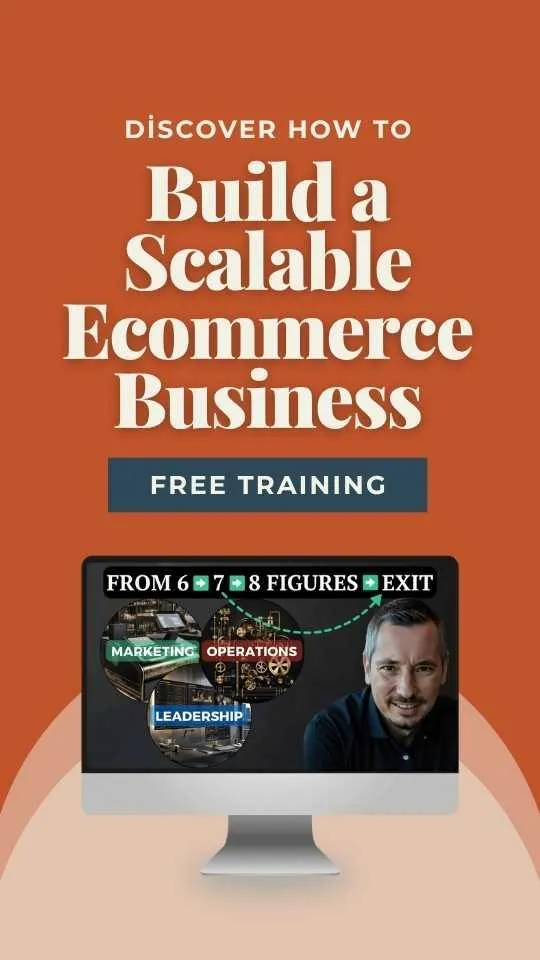What’s Considered a Good ROI for Your eCommerce Store? Maximize Profits, Minimize Waste
In the rush of running an online store, knowing your return on investment (ROI) is like having a trusty map. It tells you if the path you’re taking is leading to profitable growth.
A good ROI for eCommerce usually hovers around 15-30%, depending on your industry and strategies. Compare this to benchmarks in your field to see where you stand.
Hitting a solid ROI isn't just about numbers. It's about making smart moves. Efficient marketing, solid customer service, and smooth web navigation boost your results. Every dollar spent should feel like an investment in the customer journey, turning visitors into loyal shoppers.
If mastering your ROI feels like a mystery, don’t worry. You've got actionable strategies, data leverage, and customer-focused practices at your fingertips. Dive into these methods to enhance profits while creating unforgettable shopping experiences.
Key Takeaways
Aim for an ROI between 15-30%.
Focus on strong marketing and customer service.
Use data to refine your eCommerce strategies.
Understanding ROI in eCommerce
When you're growing your online store, understanding ROI is crucial. It's all about knowing what you're getting back from what you put in. We’ll break it down with what's essential and separate the glitter from real profit.
Defining ROI and Its Importance for Online Businesses
ROI, or Return on Investment, measures the efficiency of your spending. It tells you if your money is working as hard as you are. For eCommerce, it’s a big deal.
You're not just counting dollars; you’re deciding if that Facebook ad was worth it. Think of ROI as your profit detective. Its job is to show the success of your investments, from marketing campaigns to product stocking.
A strong ROI means you're making smart choices in your business. It ensures you're not just throwing money at problems but investing in solutions that pay off. Want to see the magic number? It’s in how much you gain compared to what you spend. A better ROI means more growth, more customers, and more cash in your pocket.
ROI vs Profit: What's the Difference?
Here's where things get interesting: not everything that shines is profit. ROI is about ratios and percentages. It shows effectiveness. Profit is what’s left when you subtract costs from revenue.
Simply put, profit is the dollars in your hand, while ROI tells you if your strategy is working.
Imagine spending $1 and getting back $5. High ROI, right? But what if that costs you $4.99 to get that $5? Not much profit there.
To sum it up: ROI measures money's muscle. Profit is the actual cash reward. Both have their place in eCommerce, but they tell different stories. Use them wisely, and you turn data into dollars.
Evaluating Your eCommerce ROI
Ready to see how your eCommerce store's doing? First, you’ll learn how to calculate ROI step by step. Then, you'll explore key metrics affecting your ROI and discover what numbers may be hiding. By the end, you’ll know exactly where you stand.
Calculating Your ROI: A Step-by-Step Guide
Start simple. ROI is a measure of your profit relative to your investment. Here's the formula:
ROI = [(Net Profit - Investment) / Investment] x 100
Imagine you spent $1,000 on marketing and made $5,000 in sales. Say your costs (including the $1,000 investment) are $3,000. Your net profit is $2,000.
Plug that into the formula:
ROI = [(2,000) / 1,000] x 100 = 200%
That's a solid ROI! Numbers don't lie. See how each dollar works for you.
Key Metrics That Influence eCommerce ROIs
You gotta watch a few things here.
Customer Acquisition Cost (CAC): It’s how much you spend to get a new buyer. Keep this low to boost profits.
Customer Lifetime Value (CLV): Predict how much revenue a customer brings over time. Aim for a high CLV against a low CAC.
Average Order Value (AOV): Increase it by upselling or bundling products. More value per order means more ROI.
For additional insight, check out ecommerce ROI metrics. These numbers help predict your store's future success.
Analyzing ROI Beyond the Numbers
ROI ain't just numbers on a page.
Think about customer feedback. Happy customers often mean a healthy ROI. Their word-of-mouth marketing is free and effective!
Check your growth over time. Are certain products leading to more sales, or does specific marketing work wonders?
Dive deep into eCommerce ROI insights.
Lastly, consider market trends. If you're ahead, ROI rises.
Crush your competition by staying informed and flexible.
Strategies to Maximize Your ROI
Maximizing ROI in your eCommerce store boils down to improving conversion rates, launching solid marketing campaigns, and crafting a personalized shopping experience. Focus on these areas: optimize every part of your digital presence, tailor your message to your audience, and use content to engage without pushing too hard.
Optimizing Conversion Rates for Better Returns
Conversion rate optimization is the lifeblood of eCommerce success. It's all about turning more clicks into sales.
Start by analyzing your website. Where do customers drop off? Tackle those spots first. Use A/B testing to try different layouts and buttons. Sometimes, just changing a color or phrasing can boost conversions.
Speed matters. Slow load times drive people away. You want your site blazing fast. One-second delay can cost you big. Also, simplify checkout. Fewer steps mean fewer chances to abandon a purchase. Make forms short and payment easy.
Data is your friend. Use it. Track metrics to see what works. Adapt your strategies based on real numbers, not guesses. Every small improvement adds up over time.
Developing High-Impact Marketing Campaigns
Throwing money at ads is not enough. You need smart campaigns that speak to your target audience.
First, define your goal. Do you want more traffic, more sales, or higher customer retention? Each goal requires a different approach. Once you know what you're after, segment your audience. A one-size-fits-all message won't cut it.
Leverage social media. It's where your customers hang out. Use it to engage directly. Run contests, share user-generated content, and respond to comments quickly. This builds loyalty and keeps your brand top-of-mind.
Email marketing is gold. Personalized emails convert better. Send offers tailored to individual preferences. Measure your results. Alter your tactics based on what gets clicks and what doesn't.
Personalization: Tailoring the Customer Experience
Personalization is like speaking directly to each customer. It makes them feel valued.
Start with product recommendations. Use browsing history and purchase patterns to suggest items. This boosts sales without being pushy.
Customize emails. Use names and tailor content to past purchases or browsing habits. Personalized messages get more opens and clicks.
Don't forget about retargeting ads. Remind visitors of what they left behind. Done right, these ads feel helpful, not annoying.
Even the checkout can be personal. Offer options based on customer preferences. Maybe someone always chooses express shipping. Show that first.
Content Marketing: The Art of Selling Without Selling
Content marketing is your secret weapon. It builds connections without a hard sell.
Create valuable content. Blogs, videos, infographics - it should be relevant and interesting. Answer questions your audience has. Educate and entertain them.
SEO matters. Optimize your content for search engines. Use keywords wisely. This draws in organic traffic. Don't stuff them in; keep it natural and readable.
Collaborate with influencers. Get the word out through trusted voices in your niche. Their audience trusts them, so if they recommend you, it's gold. Encourage user-generated content. Let your customers tell your story. They’re engaging for you, building brand authenticity.
Consistency is key. Regularly post and engage with your audience. It keeps your brand visible and relevant.
Leveraging Data for ROI Improvement
Boosting your ROI isn't just about numbers. It’s about understanding your customers and tweaking your strategies. Dive into data, focus on customer analytics, and keep testing different approaches for that continuous improvement cycle.
Customer Analytics and Lifetime Value Insights
You gotta know your customers inside and out. Customer analytics is your best friend here. Track how much each customer spends and how often they come back. This helps you figure out their lifetime value (CLV).
A higher CLV means your strategies are paying off. Use tools like Google Analytics or Mixpanel to get detailed insights. This data shows you who's buying what and how often. By comparing these metrics, you can see which customers drive the most profit. You want to focus on these high-value customers and keep them happy.
Want to up your game? Segment your audience. Tailor different offers or content for various customer groups. When you cater to their specific needs, you boost retention and ultimately, ROI.
Feedback Loops and A/B Testing: The Continuous Improvement Cycle
Don’t guess what works. Test it! A/B testing is where the magic happens. It’s about comparing two versions to see what performs better. Want more clicks on your site? Test different headlines. More sales? Try different call-to-action buttons.
Feedback loops are crucial. They help you understand what changes worked and why. Gather user feedback at every step. Listen to what your audience says about your products or site experience. Use surveys, polls, or simple emails.
Constantly test and tweak. You’ll learn what moves the needle. Data-backed decisions ensure you’re always heading in the right direction. Keep refining until each decision is driven by data, not guesswork. Keep pushing. That’s how you improve ROI.
SEO and Online Visibility
Boosting your eCommerce store's online presence is crucial for attracting customers and driving sales. To achieve this, focus on optimizing your site for search engines and ensuring fast page load speeds.
Mastering Search Engine Optimization for Organic Growth
SEO is your ticket to improving your store's visibility in organic search results. You want your store to appear at the top when potential customers search for products like yours. Focus on keyword research to understand what your audience is searching for. Tools like Google Keyword Planner can help you find high-impact keywords.
Content is king. Create high-quality, relevant content that meets your audience's needs. This could be blog posts, product descriptions, or videos. Make sure your content is engaging and adds value. Use internal linking to guide visitors to related content on your site. It helps in keeping users engaged.
Don't forget about meta tags and descriptions. These elements should include your target keywords and entice users to click on your link. Prioritizing SEO can lead to a significant boost in traffic without the cost of paid ads.
Page Load Speed: The Unsung Hero of Customer Satisfaction
Page load speed might not sound exciting, but it's a game-changer for keeping customers happy. A slow site frustrates visitors and leads to lost sales. Studies show that even a delay of a few seconds can significantly affect your conversion rate.
Use tools like Google PageSpeed Insights to check your site's speed. Aim for a load time of under three seconds. Optimize images and use caching to improve your speed. Consider a Content Delivery Network (CDN) if you have heavy media or serve a global audience.
Fast sites create a seamless experience for customers. They click, browse, and buy without waiting. So, get serious about your site speed. It's the silent salesperson working 24/7 for your store.
Social Proof and Trust-Building Tactics
Social proof can skyrocket your eCommerce game's credibility. By using reviews and content created by your customers, you win trust and boost conversions. Here's how you can make it work for you.
Leveraging Reviews and Testimonials
Imagine you're shopping online. You check the reviews before hitting "buy," right? Everyone does. Showing off customer reviews and testimonials on your site is a killer move. It feels like a friend's recommendation.
Get those glowing reviews right where visitors can see them. Use them on your landing pages, product pages, and even ads. When people see others having a great experience, it's easier for them to trust you.
Make sure you're collecting reviews consistently. Ask satisfied customers to leave feedback. You can even highlight reviews that mention specific products or services.
With more positive ratings, you build customer satisfaction and a better rep. It's like piling one more donut in your shop window. The more you have, the more enticing it gets. Reviews are your best social proof weapon.
The Power of User-Generated Content
User-generated content is the secret sauce for authenticity. Your customers can create stuff that shows off your brand and products in a way you can't. It's real. It's raw. And it's powerful.
Think about photos and videos. A selfie with your product can speak louder than any ad. Encourage your customers to share their experiences on social media. Create a hashtag or run a contest. Let them be part of your story.
Use these posts on your website, too. Display them on product pages or create a dedicated section for community highlights. The more you showcase this content, the more trust you build.
User-generated content tells potential buyers, "People like me use and love this product!" That's trust-building gold. When utilized well, it can bring your social proof game to a new level.
Sales Funnel Optimization
Boosting your eCommerce store's ROI is all about fine-tuning your sales funnel. Optimizing each stage can drive more sales, reduce cart abandonment, and turn customers into repeat buyers.
Mapping the Journey: From Awareness to Repeat Purchase
Understanding the journey from just hearing about your product to becoming a loyal customer is crucial. It starts with building awareness. Make sure people know you exist. Use social media, SEO, and ads to get on their radar.
Then, spark interest and turn it into desire. Show why your product is awesome. Clear benefits. Strong visuals. Customer reviews. That's the ticket.
Next, get them to decide. Offer easy signup and straightforward payment options. The smoother the checkout, the better.
Finally, keep them coming back. Use email campaigns or loyalty programs to encourage repeat purchases. Keep them engaged with fresh content or exclusive deals. By focusing on this journey, you make each stage a seamless step toward that repeat purchase.
Reducing Cart Abandonment and Capturing Lost Sales
Cart abandonment is a killer. You’ve almost closed the deal, and then—poof! They vanish. To get those sales back, start with a simple checkout process. Every extra click or form? Get rid of it.
Follow up with reminders. An email saying, "Hey, you left something behind!" can work wonders. Add a discount to sweeten the deal if needed.
Another trick? Use exit-intent pop-ups. Just as they’re leaving, pop up with a deal too good to refuse. It can help swing the decision your way.
Implementing these strategies can turn those ghosted carts into gold. Maximize every opportunity to finalize that sale and improve your overall ROI in a big way.
Customer Retention Strategies
Want to keep those customers coming back for more? Focus on two proven tactics: building loyalty programs that people can't resist and using email marketing to keep them engaged. Both strategies help deepen your connection with customers and boost your eCommerce ROI.
Crafting a Rock-Solid Customer Loyalty Program
A loyalty program is key to locking in customers. You want folks coming back, time and again, instead of going elsewhere. So, what makes one great?
Start with rewards that excite your customers. Points are basic, but effective. Offer discounts or freebies after a customer builds up enough points. Keep the math simple—no one likes complicated systems. Make sure your rewards align with what your customers value.
Tiered loyalty programs are another strategy. They create a sense of competition and achievement. Customers move up levels to earn better perks. It’s like a game they’ll never want to stop playing.
Keep communication clear—let them know how to earn and spend points. The more your customers use the program, the more they’ll shop with you.
Engaging Customers with Email Marketing
Email marketing isn't just newsletters. It's a powerhouse for keeping customers engaged. The key? Personalization.
Use customer data to tailor your messages. When customers see emails that cater to their interests, they're more likely to open them. Include purchase recommendations or special offers based on past behavior.
Use catchy subject lines. Imagine opening an email that's just screaming for attention. That's your goal. Make it hard to skip over your email.
Engage them with exclusive offers. Make your subscribers feel like VIPs.
And don't forget the basics—send regularly but don't spam. Timing is everything. Make the most of each email and keep them wanting more. This way, your customers stay loyal and your brand stays top of mind.
Fine-Tuning Your eCommerce Tech Stack
To get the most out of your eCommerce store, you need a solid tech stack. This means picking the right tools and optimizing payment solutions. Let’s break it down further.
Selecting the Right Tools for Your Online Store
You need a tech stack that matches your needs. Start with essential software like CRM and analytics tools. These are the backbone of smooth operations. Using the right tools can boost your store's efficiency and sales.
Consider platforms like Shopify. It offers flexibility and a wide range of apps, making it easy to tailor your store. You want platforms with strong support and easy integrations. Avoid tools that don't play nice together.
Checklist for Picking Tools:
Compatibility with existing software
Ease of use for your team
Scalability for future growth
Optimizing Payment Options for Higher Conversion
Payment options can make or break your sales. Customers need smooth transactions.
Offer multiple payment methods like credit cards, PayPal, and even Apple Pay. More payment choices mean more sales. Nobody likes limited options.
Watch out for hidden fees. They chip away at profits.
Keep things transparent and straightforward for users. Trust increases conversions.
Tips for Payment Optimization:
Choose payment gateways with low fees
Ensure security to build customer trust
Offer multiple currencies if you sell globally







